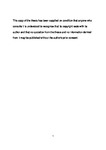Factors affecting food intake and the role of Nutrition Education in the understanding and implementation of healthy dietary habits in Saudi adolescent girls
| dc.contributor.supervisor | Collinson, Avril | |
| dc.contributor.author | Alamri, Eman | |
| dc.contributor.other | School of Health Professions | en_US |
| dc.date.accessioned | 2017-01-05T10:50:33Z | |
| dc.date.available | 2017-01-05T10:50:33Z | |
| dc.date.issued | 2017 | |
| dc.identifier | 10423410 | en_US |
| dc.identifier.uri | http://hdl.handle.net/10026.1/8197 | |
| dc.description.abstract |
Over the past two decades, the prevalence of obesity has increased among Saudi adolescents. Amongst the many environmental factors predisposing to obesity is the increase in the quantity of certain foods and changes in food quality. This study was undertaken in two phases. Phase 1 explored factors affecting food intake in Saudi adolescent girls (16-18 years) and findings from this were employed in Phase 2 which investigated a school nutrition education programme in Saudi adolescent girls. In Phase 1, cross-sectional data was gathered from 29 Saudi adolescent girls and their mothers from a single school in Tabouk City. Body mass index and waist circumference were measured and participants completed a 3-day food diary and questionnaires on nutrition knowledge, eating patterns and home food availability. The findings demonstrated that 20 (69%) of mothers were categorised within the overweight and obese category, compared to 10 (34%) of their daughters. Adolescents with higher nutritional knowledge consumed significantly more fruit (p<0.05), and significantly lower amounts of fizzy drinks, sweets and chocolate (p<0.05). In addition, mothers’ nutritional knowledge was negatively associated with 5 household availability of sweets, chocolate, cakes and biscuits (r= -0.226, p <0.05), and the availability of these products was positively associated with adolescents’ food intake (p <0.05). In phase 2, adolescent girls and their mothers were recruited from 3 matched high schools in Tabouk. A 4-week cluster randomised design was employed. Adolescents in school A received nutrition education alongside interactive nutrition activities to complete at home with their mothers, those in school B received nutrition education only, and those in school C acted as the control group. Nutrition knowledge and food frequency questionnaires were collected pre and post intervention and at a further 2 months follow up. Till receipts for food purchases were collected for 4 weeks pre intervention, and 4 weeks post intervention. In total 163 out of 229 participants (71%) completed the study across all schools. Results demonstrated that the nutrition education intervention was effective in significantly increasing nutritional knowledge (p<0.05) in adolescents from schools A and B. Adolescents in school A also showed significant improvements in their food intake (p<0.05). Mothers in school A only showed significant improvements in nutritional knowledge (p<0.05), food intake and household food purchased (p<0.05). Increasing the frequency of interactive nutrition activities shared between mother and daughter led to greater improvements in food intake (p<0.05) of mothers and daughters compared to those who interacted less frequency. In conclusion interactive activities effectively supported nutritional knowledge transfer from the school to home resulting in improvement in both adolescent and mothers’ nutritional knowledge and food intake. Interactive nutrition activities could be used for obesity prevention strategies in future research. | en_US |
| dc.language.iso | en | |
| dc.publisher | University of Plymouth | |
| dc.subject.classification | PhD | en_US |
| dc.title | Factors affecting food intake and the role of Nutrition Education in the understanding and implementation of healthy dietary habits in Saudi adolescent girls | en_US |
| dc.type | Thesis | |
| plymouth.version | publishable | en_US |
| dc.identifier.doi | http://dx.doi.org/10.24382/841 | |
| dc.identifier.doi | http://dx.doi.org/10.24382/841 | |
| dc.rights.embargoperiod | No embargo | en_US |
| dc.type.qualification | Doctorate | en_US |
| rioxxterms.funder | Not available | en_US |
| rioxxterms.identifier.project | Not available | en_US |
| rioxxterms.version | NA |
Files in this item
This item appears in the following Collection(s)
-
01 Research Theses Main Collection
Research Theses Main


